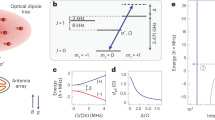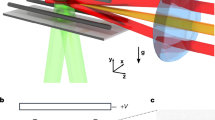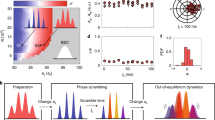Abstract
The concept of a roton, a special kind of elementary excitation forming a minimum of energy at finite momentum, has been essential for the understanding of the properties of superfluid 4He (ref. 1). In quantum liquids, rotons arise from the strong interparticle interactions, whose microscopic description remains debated2. In the realm of highly controllable quantum gases, a roton mode has been predicted to emerge due to magnetic dipole–dipole interactions despite their weakly interacting character3. This prospect has raised considerable interest4,5,6,7,8,9,10,11,12; yet roton modes in dipolar quantum gases have remained elusive to observations. Here we report experimental and theoretical studies of the momentum distribution in Bose–Einstein condensates of highly magnetic erbium atoms, revealing the existence of the long-sought roton mode. Following an interaction quench, the roton mode manifests itself with the appearance of symmetric peaks at well-defined finite momentum. The roton momentum follows the predicted geometrical scaling with the inverse of the confinement length along the magnetization axis. From the growth of the roton population, we probe the roton softening of the excitation spectrum in time and extract the corresponding imaginary roton gap. Our results provide a further step in the quest towards supersolidity in dipolar quantum gases13.
This is a preview of subscription content, access via your institution
Access options
Access Nature and 54 other Nature Portfolio journals
Get Nature+, our best-value online-access subscription
$29.99 / 30 days
cancel any time
Subscribe to this journal
Receive 12 print issues and online access
$209.00 per year
only $17.42 per issue
Buy this article
- Purchase on Springer Link
- Instant access to full article PDF
Prices may be subject to local taxes which are calculated during checkout




Similar content being viewed by others
References
Landau, L. D. The theory of superfluidity of helium II. J. Phys. (Mosc.) 5, 71–90 (1941).
Griffin, A. Excitations in a Bose-Condensed Liquid (Cambridge Univ. Press, Cambridge, 1993).
Santos, L., Shlyapnikov, G. V. & Lewenstein, M. Roton–maxon spectrum and stability of trapped dipolar Bose–Einstein condensates. Phys. Rev. Lett. 90, 250403 (2003).
Ronen, S., Bortolotti, D. C. E. & Bohn, J. L. Radial and angular rotons in trapped dipolar gases. Phys. Rev. Lett. 98, 030406 (2007).
Bohn, J. L., Wilson, R. M. & Ronen, S. How does a dipolar Bose–Einstein condensate collapse? Laser Phys. 19, 547–549 (2009).
Parker, N. G., Ticknor, C., Martin, A. M. & O’Dell, D. H. J. Structure formation during the collapse of a dipolar atomic Bose–Einstein condensate. Phys. Rev. A 79, 013617 (2009).
Martin, A. D. & Blakie, P. B. Stability and structure of an anisotropically trapped dipolar Bose–Einstein condensate: Angular and linear rotons. Phys. Rev. A 86, 053623 (2012).
Blakie, P. B., Baillie, D. & Bisset, R. N. Roton spectroscopy in a harmonically trapped dipolar Bose–Einstein condensate. Phys. Rev. A 86, 021604 (2012).
Jona-Lasinio, M., Łakomy, K. & Santos, L. Roton confinement in trapped dipolar Bose–Einstein condensates. Phys. Rev. A 88, 013619 (2013).
Wilson, R. M., Ronen, S. & Bohn, J. L. Critical superfluid velocity in a trapped dipolar gas. Phys. Rev. Lett. 104, 094501 (2010).
Natu, S. S., Campanello, L. & Das Sarma, S. Dynamics of correlations in a quasi-two-dimensional dipolar Bose gas following a quantum quench. Phys. Rev. A 90, 043617 (2014).
Pitaevskii, L. & Stringari, S. Bose–Einstein Condensation and Superfluidity Vol. 164 (Oxford Univ. Press, Oxford, 2016).
Boninsegni, M. & Prokof’ev, N. V. Colloquium: Supersolids: What and where are they? Rev. Mod. Phys. 84, 759–776 (2012).
Henshaw, D. G. & Woods, A. D. B. Modes of atomic motions in liquid helium by inelastic scattering of neutrons. Phys. Rev. 121, 1266–1274 (1961).
O’Dell, D. H. J., Giovanazzi, S. & Kurizki, G. Rotons in gaseous Bose–Einstein condensates irradiated by a laser. Phys. Rev. Lett. 90, 110402 (2003).
Mottl, R. et al. Roton-type mode softening in a quantum gas with cavity-mediated long-range interactions. Science 336, 1570–1573 (2012).
Khamehchi, M. A., Zhang, Y., Hamner, C., Busch, T. & Engels, P. Measurement of collective excitations in a spin–orbit-coupled Bose–Einstein condensate. Phys. Rev. A 90, 063624 (2014).
Ji, S.-C. et al. Softening of roton and phonon modes in a Bose–Einstein condensate with spin–orbit coupling. Phys. Rev. Lett. 114, 105301 (2015).
Ha, L.-C., Clark, L. W., Parker, C. V., Anderson, B. M. & Chin, C. Roton–maxon excitation spectrum of Bose condensates in a shaken optical lattice. Phys. Rev. Lett. 114, 055301 (2015).
Griesmaier, A., Werner, J., Hensler, S., Stuhler, J. & Pfau, T. Bose–Einstein condensation of chromium. Phys. Rev. Lett. 94, 160401 (2005).
Lu, M., Burdick, N. Q., Youn, S. H. & Lev, B. L. Strongly dipolar Bose–Einstein condensate of dysprosium. Phys. Rev. Lett. 107, 190401 (2011).
Aikawa, K. et al. Bose–Einstein condensation of erbium. Phys. Rev. Lett. 108, 210401 (2012).
Kadau, H. et al. Observing the Rosensweig instability of a quantum ferrofluid. Nature 530, 194–197 (2016).
Ferrier-Barbut, I., Kadau, H., Schmitt, M., Wenzel, M. & Pfau, T. Observation of quantum droplets in a strongly dipolar Bose gas. Phys. Rev. Lett. 116, 215301 (2016).
Chomaz, L. et al. Quantum-fluctuation-driven crossover from a dilute Bose–Einstein condensate to a macrodroplet in a dipolar quantum fluid. Phys. Rev. X 6, 041039 (2016).
Schmitt, M., Wenzel, M., Böttcher, F., Ferrier-Barbut, I. & Pfau, T. Self-bound droplets of a dilute magnetic quantum liquid. Nature 539, 259–262 (2016).
Nguyen, J. H., Luo, D. & Hulet, R. G. Formation of matter-wave soliton trains by modulational instability. Science 356, 422–426 (2017).
Wenzel, M., Böttcher, F., Langen, T., Ferrier-Barbut, I. & Pfau, T. Striped states in a many-body system of tilted dipoles. Phys. Rev. A. 96, 053630 (2017).
Li, J.-R. et al. A stripe phase with supersolid properties in spin–orbit-coupled Bose–Einstein condensates. Nature 543, 91–94 (2017).
Léonard, J., Morales, A., Zupancic, P., Esslinger, T. & Donner, T. Supersolid formation in a quantum gas breaking a continuous translational symmetry. Nature 543, 87–90 (2017).
Chin, C., Grimm, R., Julienne, P. S. & Tiesinga, E. Feshbach resonances in ultracold gases. Rev. Mod. Phys. 82, 1225–1286 (2010).
Lahaye, T. et al. d-wave collapse and explosion of a dipolar Bose–Einstein condensate. Phys. Rev. Lett. 101, 080401 (2008).
Giovanazzi, S. et al. Expansion dynamics of a dipolar Bose–Einstein condensate. Phys. Rev. A 74, 013621 (2006).
Baranov, M. Theoretical progress in many-body physics with ultracold dipolar gases. Phys. Rep. 464, 71–111 (2008).
Blakie, P., Bradley, A., Davis, M., Ballagh, R. & Gardiner, C. Dynamics and statistical mechanics of ultra-cold Bose gases using c-field techniques. Adv. Phys. 57, 363–455 (2008).
Acknowledgements
We are particularly grateful to B. Blakie for many inspiring exchanges. We thank D. O’Dell, M. Baranov, E. Demler, A. Sykes, T. Pfau, I. Ferrier-Barbut and H. P. Büchler for fruitful discussions, and G. Natale for his support in the final stage of the experiment. This work is dedicated to the memory of D. Jin and her inspiring example. The Innsbruck group is supported through an ERC Consolidator Grant (RARE, no. 681432) and a FET Proactive project (RySQ, no. 640378) of the EU H2020. L.C. is supported within a Marie Curie Project (DipPhase, no. 706809) of the EU H2020. F.W. and L.S. thank the DFG (SFB 1227 DQ-mat). All authors thank the DFG/FWF (FOR 2247). Part of the computational results presented have been achieved using the HPC infrastructure LEO of the University of Innsbruck.
Author information
Authors and Affiliations
Contributions
F.F., L.C., D.P., G.F., M.J.M., J.H.B. and S.B. conceived and supervised the experiment and collected the experimental data. L.C. analysed the data. R.M.W.v.B. developed the Bogoliubov–de Gennes calculations. F.W., R.M.W.v.B. and L.S. performed the real-time simulations. L.S. derived the analytical model and the SSM. L.C., F.F., R.M.W.v.B. and L.S. wrote the paper with contributions from all of the authors.
Corresponding author
Ethics declarations
Competing interests
The authors declare no competing interests.
Additional information
Publisher’s note: Springer Nature remains neutral with regard to jurisdictional claims in published maps and institutional affiliations.
Supplementary information
Supplementary Information
Supplementary Figure 1–3, Supplementary Table 1–2, Supplementary References
Rights and permissions
About this article
Cite this article
Chomaz, L., van Bijnen, R.M.W., Petter, D. et al. Observation of roton mode population in a dipolar quantum gas. Nature Phys 14, 442–446 (2018). https://doi.org/10.1038/s41567-018-0054-7
Received:
Accepted:
Published:
Issue Date:
DOI: https://doi.org/10.1038/s41567-018-0054-7
This article is cited by
-
Heating a dipolar quantum fluid into a solid
Nature Communications (2023)
-
Supersolidity in ultracold dipolar gases
Nature Reviews Physics (2023)
-
Vinen’s Energy Barrier
Journal of Low Temperature Physics (2023)
-
Superconductivity and topological aspects of two-dimensional transition-metal monohalides
npj Computational Materials (2022)
-
Observation of vortices and vortex stripes in a dipolar condensate
Nature Physics (2022)



